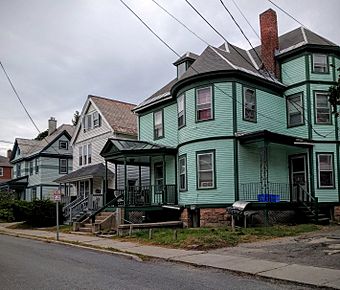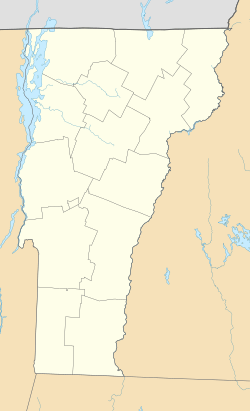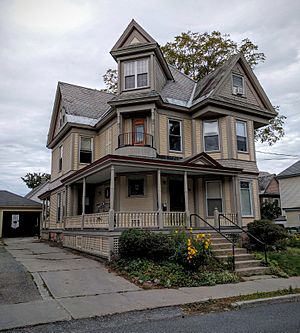Buell Street–Bradley Street Historic District facts for kids
Quick facts for kids |
|
|
Buell Street–Bradley Street Historic District
|
|
 |
|
| Location | 2-71 Bradley St., 24-125 Buell St., 16-75 Orchard Terr., 9-96 S. Union St., 11-87 Hungerford Terr., Burlington, Vermont |
|---|---|
| Area | 28 acres (11 ha) |
| Built | 1873 |
| Architectural style | Bungalow/craftsman, Colonial Revival, Queen Anne |
| NRHP reference No. | 95001260 |
| Added to NRHP | November 13, 1995 |
The Buell Street–Bradley Street Historic District is a special neighborhood in Burlington, Vermont. It's a small area with many homes located just east of the city's main downtown. This district was mostly built between 1890 and 1910. It was one of the last big neighborhoods to be built close to downtown Burlington. Because of its history and unique buildings, this area was added to the National Register of Historic Places in 1995.
Exploring This Historic Neighborhood
Burlington, Vermont, grew a lot because of its location on Lake Champlain. In the early days, many businesses were near the water. By the 1850s, cutting and selling lumber became a huge industry. Later in the 1800s, factories and shops also became very important.
How the Area Developed
Building homes in the Buell Street–Bradley Street area took a little longer. This was partly because of the land itself. There was a deep, steep valley, like a small canyon, that made building difficult. In 1849, a railroad track was built through this valley. However, the railroad was later stopped, and the valley was filled in during the 1860s. This made it possible to extend South Union Street through the area. It also opened up the land between South Union Street and South Willard Street for new buildings.
By the 1880s, this area was the last undeveloped spot near Burlington's busy downtown. So, new homes and buildings started to appear from the late 1880s until about 1930.
What You'll See in the District
The historic district has clear boundaries. To the north, it's near Pearl Street. To the east, it's close to South Willard Street. College Street is to the south. However, the district does not include any buildings right on these main streets. To the west, it's bordered by Orchard Terrace and South Union Street. These streets are just east of South Winooski Avenue, which is a major street in downtown Burlington.
Most of the buildings in this district are homes. They are usually one to three stories tall and made of wood. Many of them are built in a style called Queen Anne Victorian. This style often has towers, turrets, and decorative details. You can also find homes in other styles, like Dutch Colonial, Colonial Revival, and Bungalow.
At first, many middle-class families lived here. They worked in downtown offices or at the city's factories. Today, many college students live in the neighborhood. They attend nearby schools, especially the University of Vermont, which is just east of South Willard Street.




